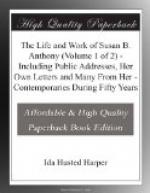CHAPTER II.
Girlhood and school-life.
1826—1838.
By 1826, Daniel Anthony had become so well-known for business management that he received an offer from Judge John McLean, of Battenville, Washington county, N.Y., who already had built a factory there, to go into cotton manufacturing on an extensive scale, the judge to furnish capital, Mr. Anthony executive ability. There was much opposition from the two older families to having their children go so far away (forty-four miles) and Lucy Anthony’s heart was almost broken at the thought of leaving her aged father and mother, but Daniel was too good a financier to lose such an opportunity. So on a warm, bright July morning the goods were started and the judge and his grandson, Aaron McLean, came with a big green wagon and two fine horses to take the family to Battenville. Young Aaron little thought as he lifted the eight-year-old Guelma into the wagon that he was taking with him his future wife. The new home was in a pretty village nestled among the hills on the Battenkill. The first year the Anthonys lived in part of Judge McLean’s house, where were two slaves not yet manumitted, and the children saw negroes for the first time and were dreadfully frightened. Afterwards the family moved into an old but comfortable story-and-a-half house where they remained several years.
Meanwhile a great deal of expensive machinery had been put into the factory and a large brick store erected. For a long time Daniel Anthony had been very much interested in the temperance cause. At Adams he had sold liquor, like every other merchant, but when a man was found by the roadside frozen to death with an empty jug which told the story, although Mr. Anthony had not sold him the rum, he resolved, as this was only one of many distressing cases, to sell no more. He was the first in that locality to put intoxicating liquors out of his store.
He had not thought to discuss this question with Judge McLean when their contract was made, and had gone to Troy and selected goods for the store. The judge looked on while they were being unloaded and finally asked, “Why, Anthony, where are the rum barrels?” “There aren’t any,” he answered. “You don’t expect to keep store without rum, do you? If you don’t ‘treat,’ nobody will trade with you,” said the judge. “Well, then I’ll close the store,” was the reply. It was opened; the farmers would come in, look around, peer behind the counter, finally go down cellar and make a search, and then declare they would not trade at a temperance store; but, as they found here the best goods and lowest prices, with square dealing, they could not afford to go elsewhere and the store soon enjoyed a large business.
When it was decided to build a number of tenement houses, the judge said, “The men will not come to the ‘raising’ unless they can have their gin.” “Then the houses will not be raised,” replied Mr. Anthony, and sent out the invitations. His wife made great quantities of lemonade, “training-day” gingerbread, doughnuts and the best of tea and coffee. Everybody came, things went off finely, not an accident during the day and all went home sober, having learned, for the first time, that there could be a house-raising without liquor.




